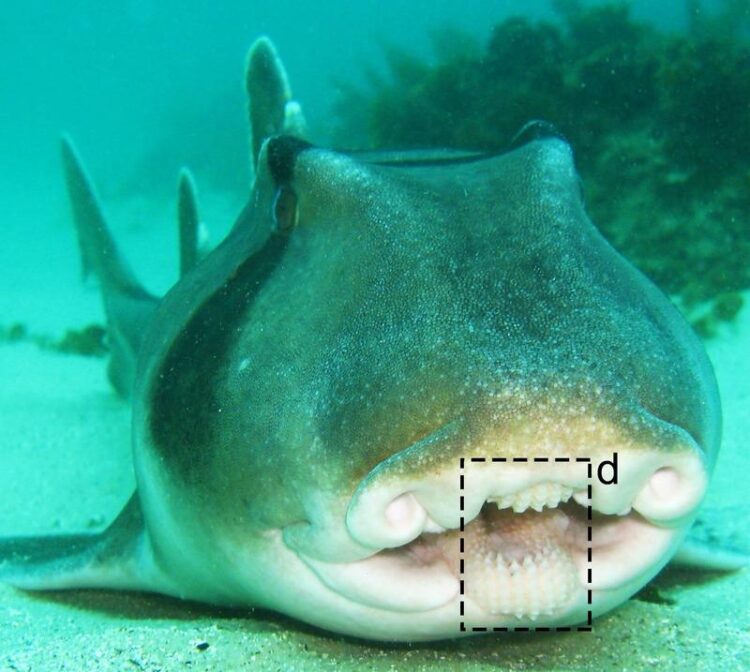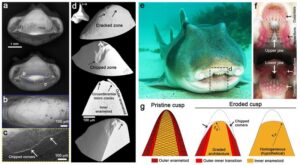And the shark, he has teeth

Zähne vom Port-Jackson-Stierkopfhai
Max-Planck-Institut für Kolloid- und Grenzflächenforschung
Form shapes function: Special feature discovered in the enamel of shark teeth.
Shark teeth must function to the point during their short retention time: The Port Jackson shark feeds on hard-shelled prey such as sea urchins, starfish, mussels and snails. Its teeth must be able to withstand high mechanical stress. The special structure of the tooth enamel ensures this continuously high performance: “The special feature is that the inner layer of tooth enameloid provides mechanical stability, while the outer one splinters off successively. This allows the tooth to retain its function,” says Dr. Shahrouz Amini. This insight provides new design paradigms for functionalized materials with exterior coatings that can be damaged and replaced, without limiting the performance.

Max Planck Institute of Colloids and Interfaces
The tooth enamel is the hardest tissue in all vertebrates, as it has to perform a strong mechanical performance and yet remain intact for decades. This is not the case with Port Jackson sharks, whose teeth are regularly renewed. “What is exciting is that all teeth differ in their overall structure, depending on their function, but are similar in their mineral composition,” says Peter Fratzl. Apatite is a naturally hard, but quite brittle material. The difference between teeth of other vertebrates and, for example, Port Jackson sharks is the unusually graded structure of the outer (enameloid) layer. Although the teeth wear out and are damaged, their function remains the same until they fall out. “In other words, the shark’s dental material is sacrificed in favor of functionality,” says Shahrouz Amini.
Biomaterials Research Department
At the Max Planck Institute of Colloids and Interfaces Prof. Dr. Peter Fratzl is one of four directors. He heads the Department of Biomaterials which investigates the construction principles of natural materials that nature has produced in the course of evolution. The focus of interest here is on the extraordinary mechanical properties of such natural materials, which are able to adapt to constantly changing external conditions.
Dr. Shahrouz Amini is a biomaterials researcher and heads the research group “Micromechanics of Biological Materials” within the Biomaterials Department. He is the first author of the enamel study published in “Nature Communications”, see link: https://www.nature.com/articles/s41467-020-19739-0
Additional authors from the Biomaterials Department include Mason Dean, Ronald Seidel (now at B CUBE in Dresden), Hajar Razi (now at ETH in Zürich) and Daniel Werner. External collaborators are James Weaver from Harvard’s Wyss Institute and Will White from CSIRO Australian National Fish Collection.
Originalpublikation:
Shape-preserving erosion controlled by the graded microarchitecture of shark tooth enameloid
http://dx.doi.org/10.1038/s41467-020-19739-0
Media Contact
All latest news from the category: Materials Sciences
Materials management deals with the research, development, manufacturing and processing of raw and industrial materials. Key aspects here are biological and medical issues, which play an increasingly important role in this field.
innovations-report offers in-depth articles related to the development and application of materials and the structure and properties of new materials.
Newest articles

Heart Surgery Risks: Low BP Linked to Postoperative Kidney Injury
First large cohort study at the Heart and Diabetes Center NRW awarded – Hilke Jung presents research project at the FoRUM conference of the Ruhr University Bochum A working group…

Microbial Secrets: Boost Plant Growth with the Power of Soil Bacteria
To stay healthy, plants balance the energy they put into growing with the amount they use to defend against harmful bacteria. The mechanisms behind this equilibrium have largely remained mysterious….

An Endless Loop: How Some Bacteria Evolve Along With the Seasons
The longest natural metagenome time series ever collected, with microbes, reveals a startling evolutionary pattern on repeat. A Microbial “Groundhog Year” in Lake Mendota Like Bill Murray in the movie…



